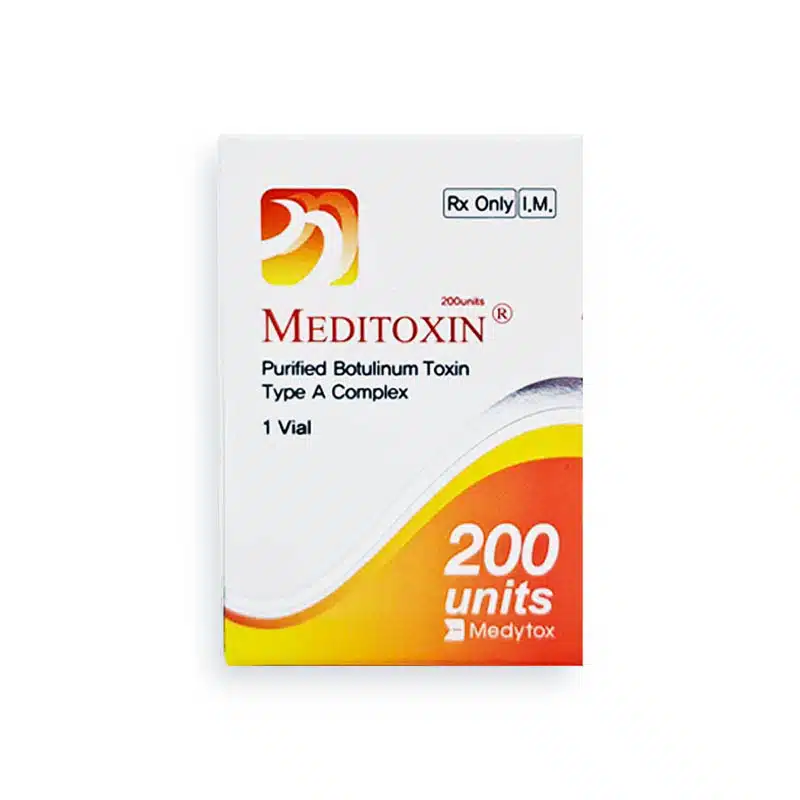Product Description
Meditoxin® 200u is a purified botulinum toxin type A complex, used globally under brand names such as Siax®, Botulift®, Cunox®, and Neuronox®. It is widely recognized for its efficacy in treating conditions related to muscle spasticity, wrinkles, and other neurological issues. Comparable to OnabotulinumtoxinA (Botox®), Meditoxin® 200u has proven safety and efficacy in various clinical studies, making it a popular choice for aesthetic and therapeutic treatments.
Meditoxin® 200u Product Features and Benefits
Key Product Details:
- Composition: Each vial contains 100 U of purified Clostridium botulinum toxin type A complex, 0.5 mg of human serum albumin, and 0.9 mg of sodium chloride.
- Presentation: Available as a lyophilized white powder in transparent vials, requiring reconstitution before use.
- Storage: Reconstituted product should be stored in a refrigerator (2-8°C) and used within 24 hours.
Administration Details:
- Reconstitution: Meditoxin® 200u should be reconstituted with 0.9% sodium chloride. Dilution tables are provided based on the desired dose per mL.
- Injection Guidance: Administer using a 24 to 30-gauge needle for superficial injections, with a longer needle recommended for deep muscles.
Meditoxin® 200u Indications for Use
Meditoxin® 200u is indicated for the treatment of several conditions, including:
- Benign essential blepharospasm: Involuntary muscle contractions around the eyes in patients aged 18 and older.
- Equinus foot deformity: Spasticity-related deformities in pediatric cerebral palsy patients aged 2 and older.
- Glabellar wrinkles: Temporary improvement of moderate to severe frown lines in adults aged 18 to 65.
- Upper limb spasticity: Muscle spasticity caused by strokes in adults aged 20 and older.
These varied applications demonstrate its broad utility in both medical and aesthetic fields.
Meditoxin® 200u Dosage Information
The dosage of Meditoxin® 200u varies depending on the condition being treated. The product is available in units of 50, 100, and 200 U, and is reconstituted with 0.9% sodium chloride. Below are the typical dosage recommendations:
1. Blepharospasm
- Initial dose: 1.25 – 2.5 U per site.
- Injections are administered into the medial and lateral pre-tarsal orbicularis oculi of the upper and lower eyelids.
- Effects appear within 3 days and peak at 1 to 2 weeks, lasting approximately 3 months.
- Maximum recommended dose per 30-day period: 200 U.
2. Pediatric Cerebral Palsy
- Total dose: 4 U/kg for hemiplegic patients or 6 U/kg for diplegic patients, divided between both legs.
- Maximum dose per treatment: 200 U.
- Clinical improvement is usually observed within 4 weeks, and injections can be repeated every 12 weeks.
3. Glabellar Wrinkles
- Total dose: 20 U, injected at 5 specific sites (2 sites on each corrugator muscle and 1 on the procerus muscle).
- Each site receives 0.1 mL of the reconstituted solution (4 U/0.1 mL).
- The effect lasts for about 3 to 4 months, and repeated treatments should be spaced at least 3 months apart.
4. Upper Limb Spasticity
- Dosage is individualized based on muscle size and severity. For instance:
- Biceps brachii: 100-200 U, divided into up to 4 sites.
- Flexor carpi radialis: 15-60 U, divided into 1 to 2 sites.
In all cases, electromyographic guidance or nerve stimulation is recommended to ensure accurate injection into the targeted muscles.
Meditoxin® 200u Side Effects and Precautions
While Meditoxin® 200u is generally well-tolerated, some side effects have been observed in clinical studies. Common adverse effects include:
- Eyelid ptosis: Drooping of the eyelid, observed in 3.2% of Meditoxin patients compared to 1.9% in Botox® patients during blepharospasm treatments.
- Extraocular muscle disorder: Reported in 0.6% of Meditoxin patients, compared to 2.6% of Botox® patients.
- Muscle weakness: A potential side effect in spasticity treatments, though rare when following dosage guidelines.
Key Precautions:
- Dose limitation: The total dose should not exceed 200 U per treatment session for blepharospasm and cerebral palsy patients.
- Electromyographic guidance: Recommended for deep muscle injections to minimize complications.
Meditoxin® 200u Clinical Studies or Real-World Outcomes
Multiple clinical studies have confirmed that Meditoxin® 200u is comparable to OnabotulinumtoxinA (Botox®) in terms of efficacy and safety. Below are some significant findings:
1. Glabellar Frown Lines
A phase III randomized clinical trial compared Meditoxin® 200u to OnabotulinumtoxinA for treating glabellar frown lines in 314 patients. The study found:
- Efficacy: Meditoxin® 200u was not inferior to Botox® in reducing the severity of wrinkles.
- Safety: No significant differences in adverse event rates between the two products.
2. Blepharospasm
Another study involving 60 patients with essential blepharospasm demonstrated:
- Effectiveness: Meditoxin® 200u showed equivalent results to Botox® in reducing spasm severity.
- Safety: Similar safety profiles were observed, with 16.1% of Meditoxin patients experiencing adverse events compared to 27.6% for Botox®.
3. Cerebral Palsy (Equinus Deformity)
A phase III trial involving 119 pediatric patients with spastic equinus foot deformity showed that Meditoxin® 200u was as effective as Botox® at reducing spasticity:
- Adverse event rate: Meditoxin® 200u had a 15.1% rate of adverse events, comparable to Botox®.
4. Post-Stroke Upper Limb Spasticity
A clinical study of 196 adult patients with spasticity following a stroke confirmed that Meditoxin® 200u was effective in improving muscle tone, with no significant differences in safety compared to Botox®.
Meditoxin® 200u Drug Interactions
Meditoxin® 200u has no known direct drug interactions. However, caution is advised for patients taking anticoagulants or other medications that increase the risk of bleeding.
Key Considerations:
Filler treatments: If used in conjunction with dermal fillers, ensure compatibility between products.
Coagulation disorders: Patients on blood thinners may experience increased bleeding at injection sites.

